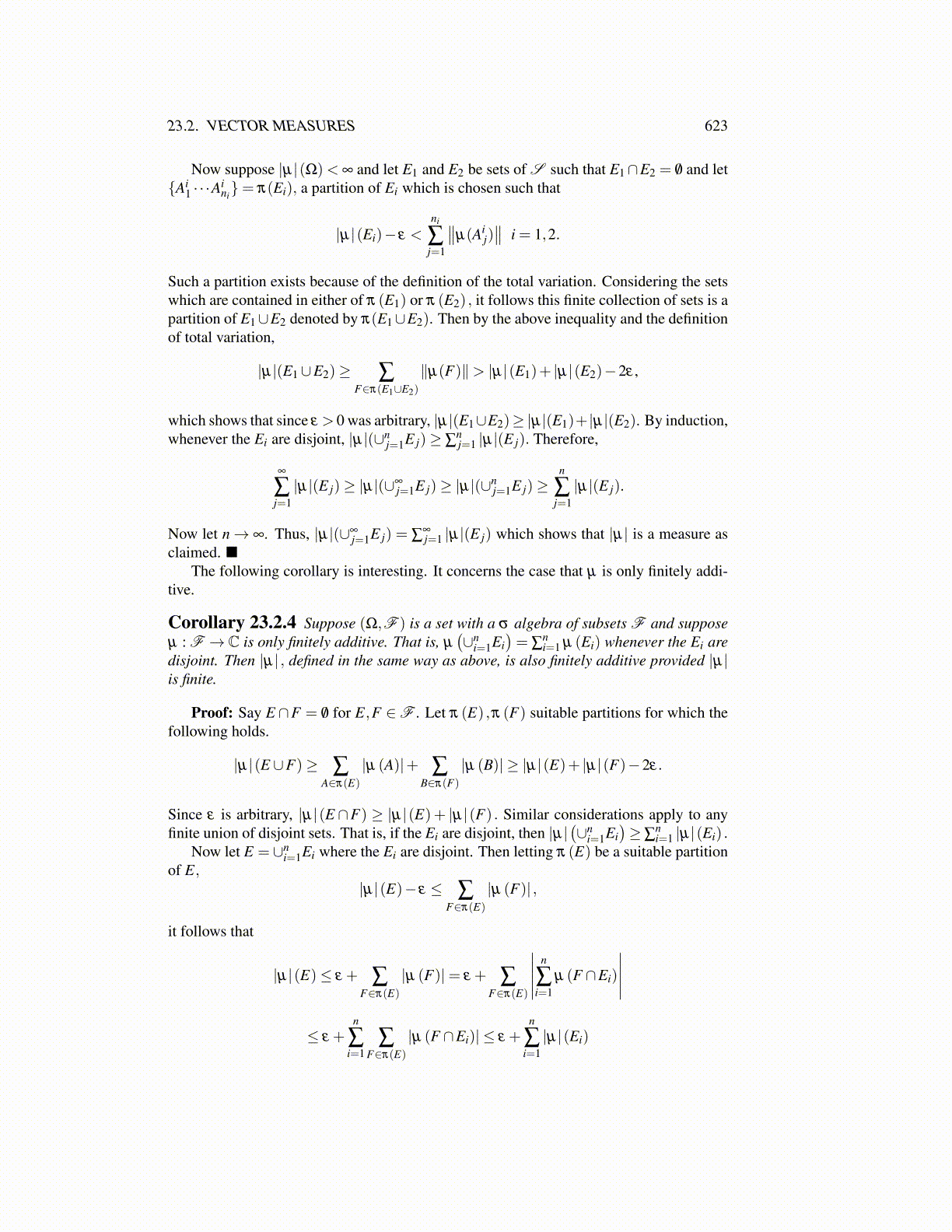
23.2. VECTOR MEASURES 623
Now suppose |µ|(Ω)< ∞ and let E1 and E2 be sets of S such that E1∩E2 = /0 and let{Ai
1 · · ·Aini}= π(Ei), a partition of Ei which is chosen such that
|µ|(Ei)− ε <ni
∑j=1
∥∥µ(Aij)∥∥ i = 1,2.
Such a partition exists because of the definition of the total variation. Considering the setswhich are contained in either of π (E1) or π (E2) , it follows this finite collection of sets is apartition of E1∪E2 denoted by π(E1∪E2). Then by the above inequality and the definitionof total variation,
|µ|(E1∪E2)≥ ∑F∈π(E1∪E2)
∥µ(F)∥> |µ|(E1)+ |µ|(E2)−2ε ,
which shows that since ε > 0 was arbitrary, |µ|(E1∪E2)≥ |µ|(E1)+ |µ|(E2). By induction,whenever the Ei are disjoint, |µ|(∪n
j=1E j)≥ ∑nj=1 |µ|(E j). Therefore,
∞
∑j=1|µ|(E j)≥ |µ|(∪∞
j=1E j)≥ |µ|(∪nj=1E j)≥
n
∑j=1|µ|(E j).
Now let n→ ∞. Thus, |µ|(∪∞j=1E j) = ∑
∞j=1 |µ|(E j) which shows that |µ| is a measure as
claimed. ■The following corollary is interesting. It concerns the case that µ is only finitely addi-
tive.
Corollary 23.2.4 Suppose (Ω,F ) is a set with a σ algebra of subsets F and supposeµ : F → C is only finitely additive. That is, µ
(∪n
i=1Ei)= ∑
ni=1 µ (Ei) whenever the Ei are
disjoint. Then |µ| , defined in the same way as above, is also finitely additive provided |µ|is finite.
Proof: Say E ∩F = /0 for E,F ∈F . Let π (E) ,π (F) suitable partitions for which thefollowing holds.
|µ|(E ∪F)≥ ∑A∈π(E)
|µ (A)|+ ∑B∈π(F)
|µ (B)| ≥ |µ|(E)+ |µ|(F)−2ε.
Since ε is arbitrary, |µ|(E ∩F) ≥ |µ|(E)+ |µ|(F) . Similar considerations apply to anyfinite union of disjoint sets. That is, if the Ei are disjoint, then |µ|
(∪n
i=1Ei)≥∑
ni=1 |µ|(Ei) .
Now let E = ∪ni=1Ei where the Ei are disjoint. Then letting π (E) be a suitable partition
of E,|µ|(E)− ε ≤ ∑
F∈π(E)|µ (F)| ,
it follows that
|µ|(E)≤ ε + ∑F∈π(E)
|µ (F)|= ε + ∑F∈π(E)
∣∣∣∣∣ n
∑i=1
µ (F ∩Ei)
∣∣∣∣∣≤ ε +
n
∑i=1
∑F∈π(E)
|µ (F ∩Ei)| ≤ ε +n
∑i=1|µ|(Ei)